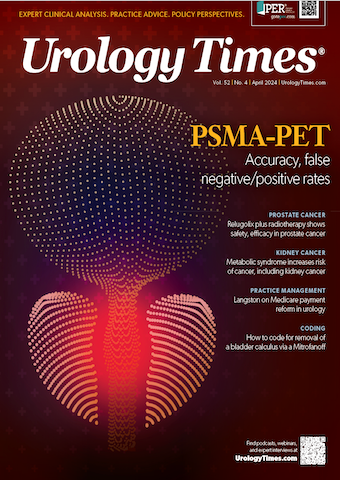News
Article
Urology Times Journal
PARP inhibitors, imaging and diagnostic advances among recent prostate cancer highlights
Author(s):
“The impact of precision medicine in prostate cancer has been significant over a relatively brief period,” says Leonard G. Gomella, MD, FACS.
Leonard G. Gomella, MD, FACS

In a presentation during the 17th Annual Interdisciplinary Prostate Cancer Congress® and Other Genitourinary Malignancies, an event hosted by Physician’s Education Resource (PER®), in New York, New York, Leonard G. Gomella, MD, FACS, hailed precision medicine’s transformative influence on prostate cancer.1
“The impact of precision medicine in prostate cancer has been significant over a relatively brief period,” Gomella, meeting cochair and Bernard W. Godwin, Jr. Professor in Prostate Cancer, chairman in the Department of Urology, senior director of clinical affairs, Sidney Kimmel Cancer Center, and the Enterprise Vice President of Urology at Jefferson Health System of Thomas Jefferson University in Philadelphia, Pennsylvania, said.
“Advances in imaging and detection methods allow more focused screening and diagnostic methods, and translational research discoveries have led to new classes of targeted therapeutic agents. Numerous trials now focus on precision medicine ‘targeted therapy.’”
Research with genetics and genomics, which evolved into a greater understanding of biomarkers, helped form the basis of current precision medicine advances in the field, which can be used to determine disease risk, guide prostate biopsy, inform early prostate cancer treatment or recommend active surveillance, and improve outcomes in care for those with advanced disease.
Today, evidence of ongoing precision approaches includes basket/bucket and umbrella trials zeroed in on molecular subtypes, as well as explorative strategies to de-escalate radiation or androgen deprivation therapy (ADT) use.
The Groundwork for Prostate Cancer Genomics
Gomella cited the early days of implementing germline testing in prostate cancer, previously identified during the Philadelphia Prostate Cancer Census, which was the first comprehensive, multidisciplinary consensus statement that “addressed a genetic evaluation framework for inherited prostate cancer in the multigene testing era.”2
“Many members of the faculty here today participated in our first international consensus meeting in Philadelphia, looking at the role of genetic testing for inherited prostate cancer risk,” Gomella said. “You have to realize: we’re relatively new to the game.”
Research changed into an evolving role of liquid biopsy for tumors, detection of hematogenous micrometastasis, early disease detection, and inherited genes, including BRCA1/2. Polygenetic and genetic risk scores, which complement family history and rare pathogenic mutations, have helped to stratify the risk of prostate cancer while also predicting the risk of disease incidence and mortality.3 Results showed that BRCA2-mutant disease have a worse prognosis in both overall survival (OS)4 and metastasis-free survival.5
“[Genetic testing has] basically here for many years, looking at the personal history, familial cancer or a known germline mutation that runs in the family,” he explained. “Again, those direct how you screen, or think about screening, in patients that might have increased risk based on a genetic basis of having prostate cancer.”
Gomella cited precision medicine guides to perform prostate biopsy that have led to breakthroughs, including the use of online calculators, molecular blood test, prostate-specific antigen (PSA)-related blood tests, and urine-based assays. Imaging tests include MRI, micro-ultrasound, and contrast-enhanced ultrasound. Then, assays such as GPS, Prolaris, Decipher, Prostatype, Natera, and ConfirmMDx have also cascaded into the element of helping to inform treatment decisions.
For example, a low Decipher score can determine that patients with prostate cancer will not experience oncologic benefit from radiation at lower PSA levels, whereas a Decipher High score shows that men are likely to have substantial oncologic benefit from radiation at lower PSA levels.6
Most recently, the use of artificial intelligence (AI) through ArteraAI has been granted level 1B evidence with a category 2A recommendation by National Comprehensive Cancer Network guidelines as a prognostic tool for biochemical recurrence, distant metastases, and prostate cancer–specific mortality.7
Researchers experimented with AI to determine whether all men with early prostate cancer and radiation require ADT. In the review, investigators showing that AI-driven digital histopathology enabled the first predictive biomarker to guide ADT use in localized prostate cancer. Specifically, approximately two-thirds of patients with intermediate-risk disease could avoid ADT irrespective of their prognosis as a benefit was not noted.8
Translating to Treatment Decisions
The androgen receptor (AR)-V7 slice variant also was found to be a mechanism of resistance to AR-targeted therapy, Gomella explained. For example, those with AR-V7–negative disease may live longer on AR-targeted therapy compared with taxane therapy. Data showed that the median OS in this subgroup was 19.8 months for those on AR-directed treatment vs 12.8 months on the on taxane therapy.9
As it relates further to somatic testing, which evaluates more than 300 actionable genes, Gomella emphasized the importance of testing for tumor mutational burden and microsatellite instability. The use of testing can help determine if a patient is eligible to receive treatment with the PD-L1 inhibitor pembrolizumab (Keytruda).
These testing advances have shown details on homologous recombination repair (HRR) mutations. For example, BRCA2, as seen in 44% of patients with metastatic castration-resistant prostate cancer (mCRPC), is a preferred target to study for potential screening and treatment, and those with the mutation tend to have more aggressive disease.10
Through the BRCA2 understanding came FDA approvals of both olaparib (Lynparza) and rucaparib (Rubraca) in 2020 based off the phase 3 PROfound (NCT02987543)11 and TRITON312 (NCT02975934) trials, respectively. The indication for olaparib is for adult patients with deleterious or suspected deleterious germline or somatic HRR gene-mutated mCRPC who have progressed following prior treatment with enzalutamide (Xtandi) or abiraterone acetate (Zytiga). For rucaparib, it is designated for patients with germline or somatic BRCA mutation mCRPC who have been treated with AR–directed therapy and a taxane-based chemotherapy.
Subsequently, in the phase 3 TALAPRO-2 trial (NCT03395197)13, treatment with talazoparib (Talzenna) combined with enzalutamide (Xtandi) led to a 55% reduction in the risk of disease progression or death in patients with HRR-deficient mCRPC. These findings led to the June 2023 FDA approval of talazoparib with enzalutamide for patients with HRR gene-mutated mCRPC.
References
1. Gomella LG. Precision medicine to improve outcomes in prostate cancer. Presented at: 17th Annual Interdisciplinary Prostate Cancer Congress® and Other Genitourinary Malignancies; March 8-9, 2024; New York, NY.
2. Giri VN, Knudsen KE, Kelly WK, et al. Role of genetic testing for inherited prostate cancer risk: Philadelphia Prostate Cancer Consensus Conference 2017. J Clin Oncol. 2018;36(4):414-424. doi:10.1200/JCO.2017.74.1173
3. Seibert TM, Garraway IP, Plym A, et al. Genetic risk prediction for prostate cancer: implications for early detection and prevention. Eur Urol. 2023;83(3):241-246. doi:10.1016/j.eururo.2022.12.021
4. Castro E, Goh C, Olmos D, et al. Germline BRCA mutations are associated with higher risk of nodal involvement, distant metastasis, and poor survival outcomes in prostate cancer. J Clin Oncol. 2013;31(14):1748-1757. doi:10.1200/JCO.2012.43.1882
5. Castro E, Goh C, Leongamornlert D, et al. Effect of BRCA mutations on metastatic relapse and cause-specific survival after radical treatment for localised prostate cancer. Eur Urol. 2015;68(2):186-193. doi:10.1016/j.eururo.2014.10.022
6. Den RB, Yousefi K, Trabulsi EJ, et al. Genomic classifier identifies men with adverse pathology after radical prostatectomy who benefit from adjuvant radiation therapy. J Clin Oncol. 2015;33(8):944-51.doi:10.1200/JCO.2014.59.0026.
7. NCCN. Clinical Practice Guidelines in Oncology. Prostate Cancer, version 4.2023. Accessed February 4, 2024. https://www.nccn.org/guidelines
8. Spratt DE, Tang S, Sun Y, et al. Artificial intelligence predictive model for hormone therapy use in prostate cancer [Preprint]. 2023:rs.3.rs-2790858.doi:10.21203/rs.3.rs-2790858/v1.
9. Tagawa ST, Antonarakis ES, Gjyrezi A, et al. Expression of AR-V7 and ARv567es in circulating tumor cells correlates with outcomes to taxane therapy in men with metastatic prostate cancer treated in TAXYNERGY. Clin Can Res. 2019;25(6):1880-1888. doi:10.1158/1078-0432.CCR-18-0320
10. Pritchard CC, Mateo J, Walsh MF, et al. Inherited DNA-Repair gene mutations in men with metastatic prostate cancer. N Engl J Med. 2016;375(5):443-453. doi:10.1056/NEJMoa1603144.
11. FDA approves olaparib for HRR gene-mutated metastatic castration-resistant prostate cancer. FDA. News release. May 19, 2020. Accessed March 8, 2024. https://www.fda.gov/drugs/resources-information-approved-drugs/fda-approves-olaparib-hrr-gene-mutated-metastatic-castration-resistant-prostate-cancer
12. Fizazi K, Piulats JP, Reaume MN, et al. Rucaparib or physician's choice in metastatic prostate cancer. N Engl J Med. 2023;388(8):719-732.doi:10.1056/NEJMoa2214676.
13. Agarwal N, Azad AA, Carles J, et al. Talazoparib plus enzalutamide in men with first-line metastatic castration-resistant prostate cancer (TALAPRO-2): a randomised, placebo-controlled, phase 3 trial. Lancet. 2023;402(10398):291-303. doi: 10.1016/S0140-6736(23)01055-3.


























